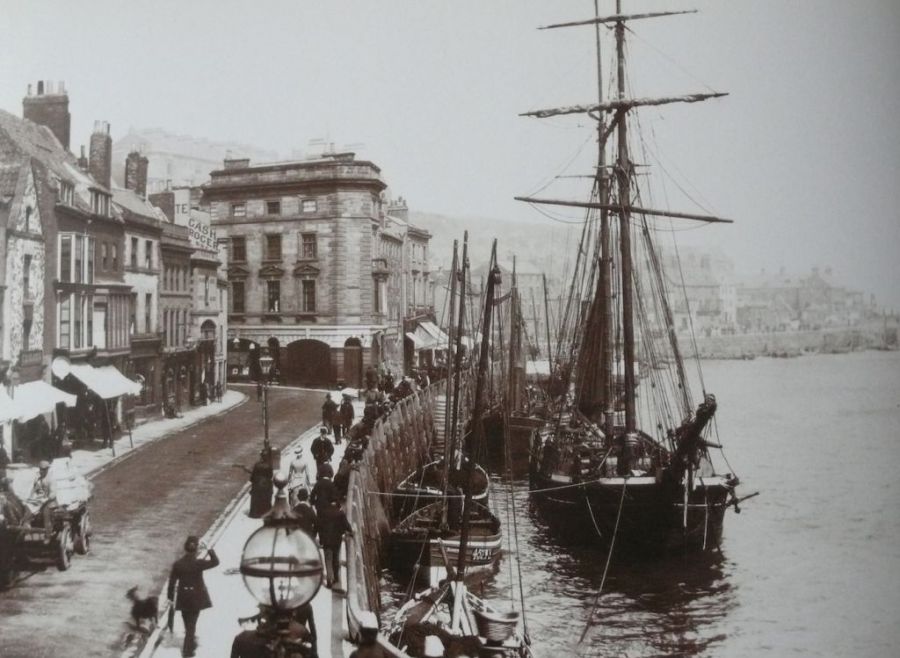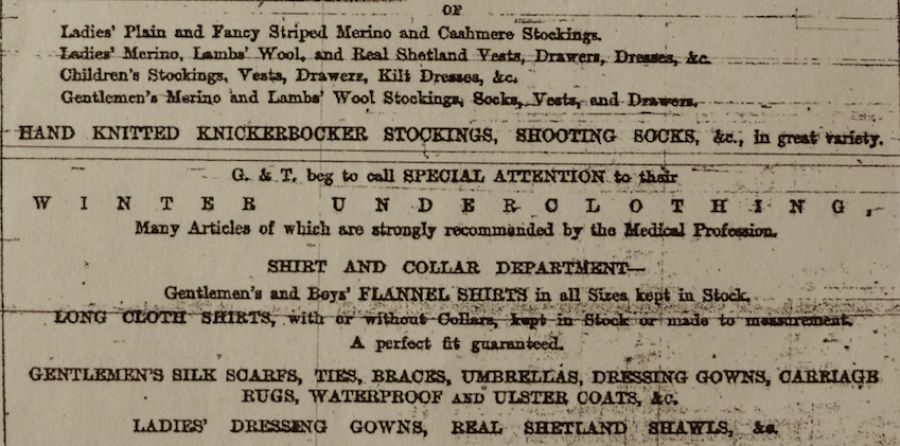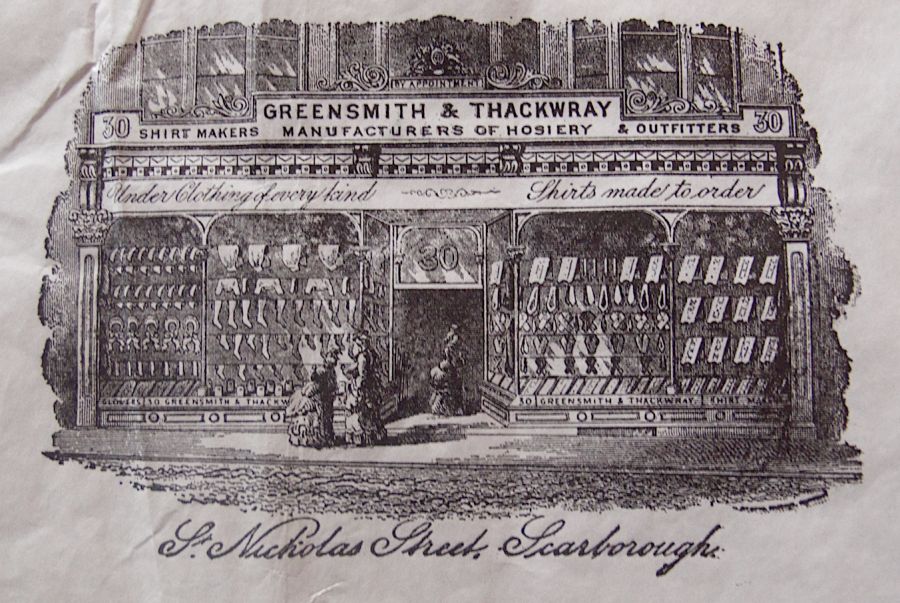ikfoundation.org
The IK Foundation
Promoting Natural & Cultural History
Since 1988


WOOLLEN MOVEMENT & HEALTH ASPECTS
– in the late 19th Century
Clothes and domestic textiles were important for health and fighting illness in the Victorian era. One aspect was that it was healthy to keep warm, and in this respect, woollen clothes were unbeatable. Hence, the Woollen Movement was introduced in the 1870s; central to this was woollen underclothes, but all kinds of woollen garments now became more popular, even among the wealthy, who had previously preferred cotton and silk material. Medical or health aspects were emphasised. This case study will give a few examples of woollen clothes of these types sold by the hosiers, glovers and shirt makers Greensmith & Thackwray in Whitby, among other traders.
 This contemporary photograph by Frank Meadow Sutcliffe taken in the 1870s or 1880s, gives a good view of the position of St Ann’s Staith by the River Esk, where Greensmith & Thackwray’s shop was situated around that time. Their shop at No. 12 must have been behind one of awnings to the left in picture. (Photo: Frank Meadow Sutcliffe).
This contemporary photograph by Frank Meadow Sutcliffe taken in the 1870s or 1880s, gives a good view of the position of St Ann’s Staith by the River Esk, where Greensmith & Thackwray’s shop was situated around that time. Their shop at No. 12 must have been behind one of awnings to the left in picture. (Photo: Frank Meadow Sutcliffe).A study of advertisements in the local Whitby Gazette only gets some evidence for “the Woollen Movement” in this small coastal town of North Yorkshire, but in the 1870s an increased amount of woollen clothes were despite this for sale. Whitby’s position as a holiday centre and health resort may also have been a factor for that some hosiers and drapers stressed the importance of woollen underclothes. For example, on 9th November 1878, Robert Gray & Co. at Old Market Place announced a large advert describing all possible varieties in their stock and listing ‘Wool Under Shirts, White and Shetland’, ‘White Merino Shirts’ and ‘White and Shetland Wool pants’ among many wares. Unlike cotton and silk underclothes, woollen models worn mainly to keep warm are not represented in the Whitby Museum Costume Collection.
 Greensmith & Thackwray at no. 12 St. Ann’s Staith in Whitby, particularly emphasised the importance of all sorts of ‘Winter Underclothing – Many Articles of which are strongly recommended by the Medical Profession’ in this advert (part of) from 18th November in 1876. (Whitby Museum, Library & Archive). Photo: Viveka Hansen.
Greensmith & Thackwray at no. 12 St. Ann’s Staith in Whitby, particularly emphasised the importance of all sorts of ‘Winter Underclothing – Many Articles of which are strongly recommended by the Medical Profession’ in this advert (part of) from 18th November in 1876. (Whitby Museum, Library & Archive). Photo: Viveka Hansen.This family hosiers, glovers, and shirt makers was however a short-lived business in Whitby according to advertisements during a few years in the late 1870s. Greensmith & Thackwray in Whitby was a branch of the main shop with a longer life in Scarborough – founded in 1845 and still active according to Bulmer’s Directory in 1890 under the heading Hosiers, Glovers &c and lived on as a store up to the late 1980s.
 This print gives a rare opportunity to study the kind of wares Greensmith & Thackwray had for sale, as well as their technique of window dressing to attract their clientele. Judging by the ladies dressed in skirts supported by bustles viewing the shop windows of their shop in Scarborough, this print originates from the 1870s or 1880s. (Print on paper bag, private ownership).
This print gives a rare opportunity to study the kind of wares Greensmith & Thackwray had for sale, as well as their technique of window dressing to attract their clientele. Judging by the ladies dressed in skirts supported by bustles viewing the shop windows of their shop in Scarborough, this print originates from the 1870s or 1880s. (Print on paper bag, private ownership).More to read about “the Woollen Movement” can be found in Alison Adburgham’s research into the subject from a broader perspective – Shops and Shopping 1800-1914 (pp.184-98) printed in 1964. Among many matters, Adburgham described:
- Dr Jaeger and Sanitary Woollen Underclothing.
- The Rational Dress Society and Hygienic Wearing Apparel.
- Chamois Leather Underwear.
- Knitted Outerwear.
- Parcels for the Poor and for Servants.
- Welsh flannels
- Tennis clothes.
Sources:
- Adburgham, Alison, Shops and Shopping 1800-1914, London 1964.
- Hansen, Viveka, The Textile History of Whitby 1700-1914 – A lively coastal town between the North Sea and North York Moors, London & Whitby 2015 (chapter III).
- Whitby Gazette, 1870-1890 (Whitby Museum, Library & Archive).
- Whitby Museum, Photographic Collection (studies of local photographs).
More in Books & Art:
Essays
The iTEXTILIS is a division of The IK Workshop Society – a global and unique forum for all those interested in Natural & Cultural History from a textile Perspective.
Open Access essays, licensed under Creative Commons and freely accessible, by Textile historian Viveka Hansen, aim to integrate her current research, printed monographs, and earlier projects dating back to the late 1980s. Some essays feature rare archive material originally published in other languages, now available in English for the first time, revealing aspects of history that were previously little known outside northern European countries. Her work also explores various topics, including the textile trade, material culture, cloth manufacturing, fashion, natural dyeing, and the intriguing world of early travelling naturalists – such as the "Linnaean network" – viewed through a global historical lens.
For regular updates and to fully utilise iTEXTILIS' features, we recommend subscribing to our newsletter, iMESSENGER.
been copied to your clipboard




– a truly European organisation since 1988
Legal issues | Forget me | and much more...
You are welcome to use the information and knowledge from
The IK Workshop Society, as long as you follow a few simple rules.
LEARN MORE & I AGREE







